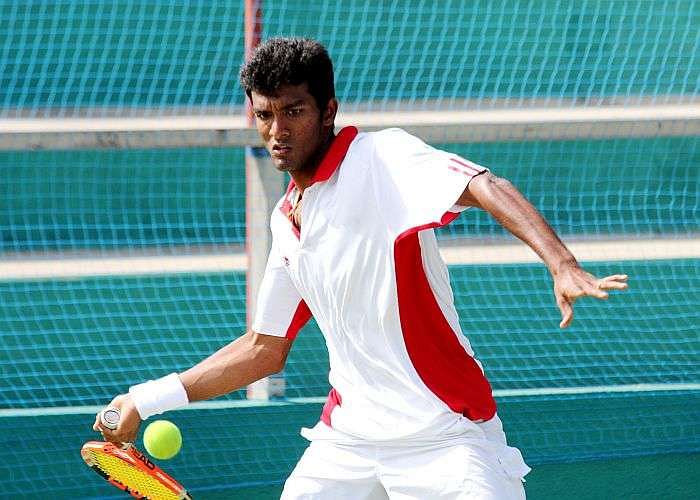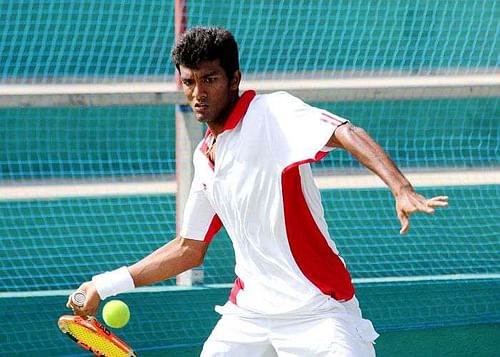
INTERVIEW: "I can't wait to represent India at the Davis Cup," says N. Sriram Balaji

India's Davis Cup side has seen a big shakeup in the week before they host a tie against Uzbekistan – and by that shakeup, we mean a total do-over. Indian former World No. 1 Mahesh Bhupathi took over the reins of the team from former professional Anand Amritraj this year, and the ace has catalyzed significant changes.
N. Sriram Balaji, a constant presence on the Futures circuit over the past two years, has been granted a place on the main team – and he is over the moon. “It’s my first time in the main team, I get to represent my country in team tennis. I was on the reserve squad before, so to get on the main squad is just a dream come true!”
But he did not know until the last moment that he was in the first-string team. “I knew I was on the team, but I could just have been a reserve again,” he says. “Only two days back, Mahesh called me and told me I was on the main team, that I would get to play. I couldn’t believe it, I was so happy. I only found out at the last minute, when everyone else – the public – did!”
The road hasn’t always been easy for Sriram, or ‘Bala’ as his friends call him. “I had quite a few injury struggles in 2015,” he says, “injuries that sidelined me majorly. I was struggling so badly I could barely move, but then 2016 was filled with tournaments. I’ve played, and played, and then some, and it’s been a great year for me in terms of climbing up the rankings as well.”
Fresh off a title win at an ITF event in Trivandrum, he reveals that he will hit his career-highest ranking on Monday, the 3rd of April 2017 – 305. For someone who has struggled as much as he has, Sriram was still unsure.
“We’ve all been playing quite a lot,” he says, “me, Prajnesh (Gunneswaran), and Yuki. I played them in those finals too, won two, lost one to Yuki, lost one to Prajnesh, so it was quite a close toss-up between us. Eventually we all made the team! We’re also really good friends off the court – especially Prajnesh, as I’ve known him for so long – through training, our professional careers, everything.”
That friendship, he says, is key to team bonding – and a factor that could stand the Indian team in good stead come the tie. “Because we’re friends off the court, we bond better as a team on it, he says. We aren’t just a bunch of random tennis professionals playing together – we have a sense of team, a sense of bonding already, and that really, really helps on-court chemistry – it could really improve our game too.”
But it was not a simple climb. “I had to play a lot, a lot of matches to move up the rankings,” he says. “I was travelling a lot, and that wasn’t easy, but it is worth it.”
Bala’s injuries were much more serious than believed. “My L4 and L5 were in constant pain,” he says, about his lower vertebral injuries. “It was so painful that I’d have to stand up every half an hour because sitting still ached.”
Recommended surgery, Bala decided to take a second opinion – and a third. “After I consulted further, doctors told me there was only a 50% chance that surgery would do anything at all, that it would even help,” he said, and so I decided against it.
And then began rigorous physiotherapy.
Motivation was never a struggle for Bala despite the pain, however. “I kept believing in myself – I had to,” he says, “and it was that confidence, that self-belief that kept me going through the pain.”
That confidence continues to stay strong for the player, who says he is raring to go for the Davis Cup tie. “I am match sharp,” he says, “just because of the sheer amount of tournaments I’ve played lately. The past 6 months, I’ve done nothing but play!”
“Mahesh felt that we were performing better, and lately we have had more wins than Paes and Bopanna, but of course we’ve been playing on different levels – they are at Grand Slams and Masters and we are on the Futures...”
A Federer fan through and through, the 27-year-old ace has been playing tennis quite a long time – eighteen years, in fact. “I was the kind of kid that would play everything and anything,” he says, “but I had a special skill for tennis. So my dad helped me and supported me, and I devoted myself to tennis. It really helped that I grew up near Perks (one of the most well-known schools in the Southern Indian city of Coimbatore, well-known for its tennis facilities), and that I could train and study there as well.”
The struggles of a sporting career
Despite his injuries, he says, there is one significant thing he did not have to struggle with – convincing his parents to let him pursue a career in sport. “A lot of parents still don’t see their kids taking up sport as a viable career option, as sustainable financially, and many are forced to withdraw. My father is a former volleyball player, and so he saw my passion, and understood, he says.”
But the struggle is very real for many other players. “There were so many talented guys, playing with me, when I was playing, who could have done so many things, maybe even better than me, but they could not stay in the sport. A few months of bad results, or no wins, and they were forced to withdraw, many of them shifting their focus to full-time education.”
“I have so many friends,” he tells me, “who I used to hit with, who are now working IT jobs in India and abroad. And you can’t really blame them because it’s difficult to keep money coming, and with sports you need to self-fund until you can get sponsorships, funding, it’s a really big problem.”
“But there are extremes,” he says, “even among the parents. There are of course those with genuine issues, but a lot of parents put their kid into tennis until they’re 15 or 16, and then tell them to quit it – even if they’re doing okay. And then the other extreme is parents who want their kids to be 100% in both. That’s difficult, not really going to happen, and it’s a lot of unnecessary pressure on a child pushing to succeed in both,” he says.
“Then there are families who firmly believe in the ‘sport is not a career’ adage,” he says, and they refuse to let children carry on in sport.
Indian tennis takes a hit
”Tennis is suffering in this country because there are no sponsorships,” Bala says. We are losing so much talent this way. These children need to be groomed from a young age, their skills picked up, honed, worked on and shaped to the best way that the player needs. These kids will also be able to play more comfortably knowing they have the assurance of a future, that they won’t have to struggle financially,” he says. “It’s all commercial.”
A number of coaches, Bala says, are not well-versed with coaching methods, serves and even how to hold the racquet or adapt to a modern-day game. “They just look at the player's forehand, backhand, that’s it. Just that. And they’re still with the continental grip – just that grip. They won't teach them eastern grips, how else to hold the racquet, or even adapting their own game.”
“A lot of coaches are also very money-minded,” he says, “and only a few are actually experienced in what they are supposed to be teaching. And this doesn’t just happen in India. Even in foreign academies, where kids are paying a lot of money to train, they aren’t even necessarily trained by coaches – but markers on the court. It’s not great.”
“Guidance is key. And guidance is being missed out,” he says.
Bala is among a number of players attempting to help and guide younger players in the sport. “I’ll speak to them personally, and guide them whenever I get the chance,” he says, “and so I try to seek out the upcoming juniors to help.”
It is here that he lauds the significant efforts of former Indian No. 1 Somdev Devvarman, who retired from professional tennis in 2016. “Somdev is a wonderful human being,” he says, “and he is always trying to guide the young players, help them, push them ahead. He’s been helping a lot, and trying to set up facilities in Chennai as well. He is close to a lot of the players and personally helps them out.”
It is former players who have been the biggest driving force behind pushing for new talent, Bala tells me. Mahesh Bhupathi in particular has been providing the impetus for some of the country’s best young talents, and personally took up the cause of 19-year-old singles player Sumit Nagal when the player was only 12. “Sumit is training with us in Germany (at the Schuttler-Waske Tennis University,” he says, “and I can see myself how much he has grown. And Mahesh takes personal interest in the players, and that alone gives us so much motivation.”
Hands-on support from Mahesh Bhupathi
Bhupathi’s support looks to have significantly boosted the morale of the team, and Bala affirms this. “Mahesh has been following all of our progress over the past weeks, and constantly been watching our tournaments, our wins and results, and contacting us all regularly. When I won last week, he called me up to congratulate me. To know that the legend, who has won so many Slams, one of the best players India has ever produced cares about us and our game, it pushes us to do so much better.”
“Mahesh calls and messages all of the players week on week, on a regular basis, every single player on the team.”
That captaincy and leadership has bolstered the team in terms of motivation and bonding – and Bhupathi's first jaunt as India’s Davis Cup captain appears to already have been a good decision.
India’s Davis Cup tie against Uzbekistan will begin on the 7th of April 2017 at the KSLTA Tennis Stadium in Bengaluru, India.